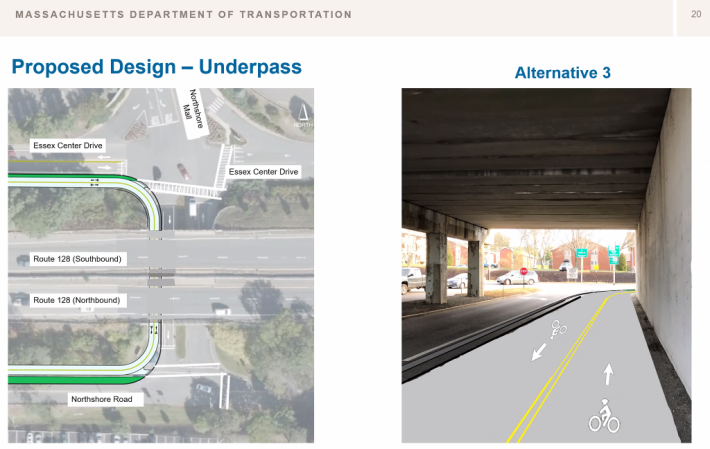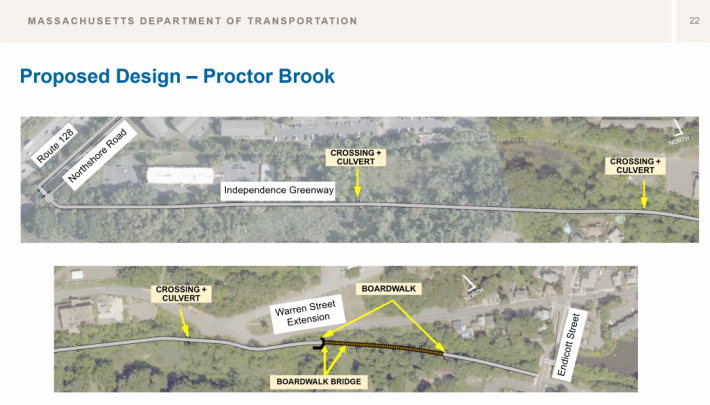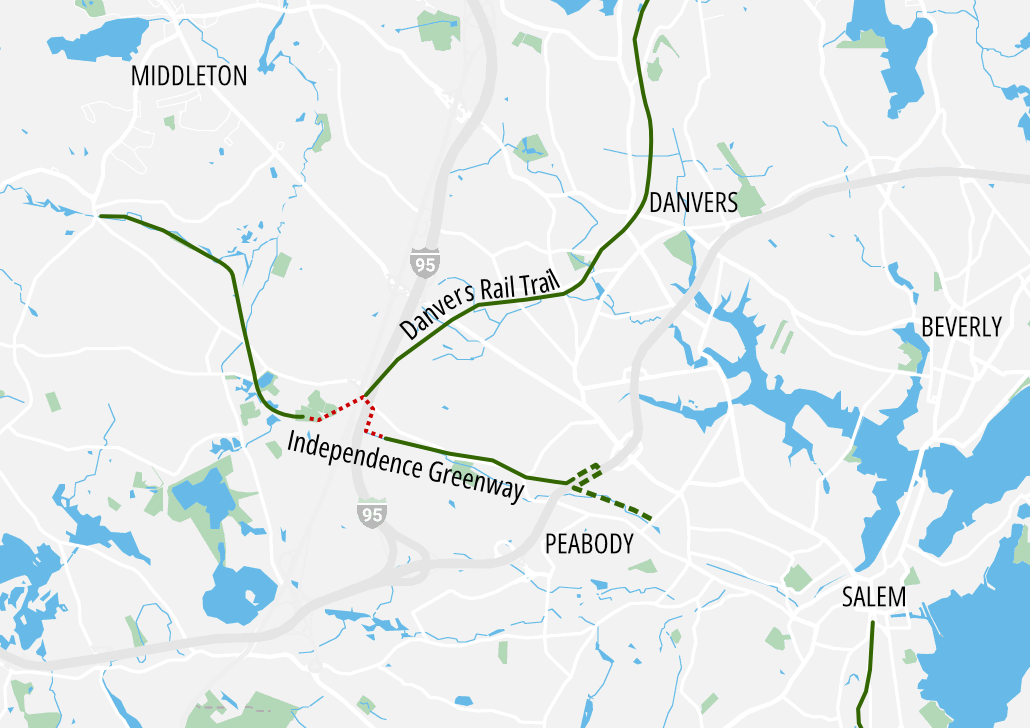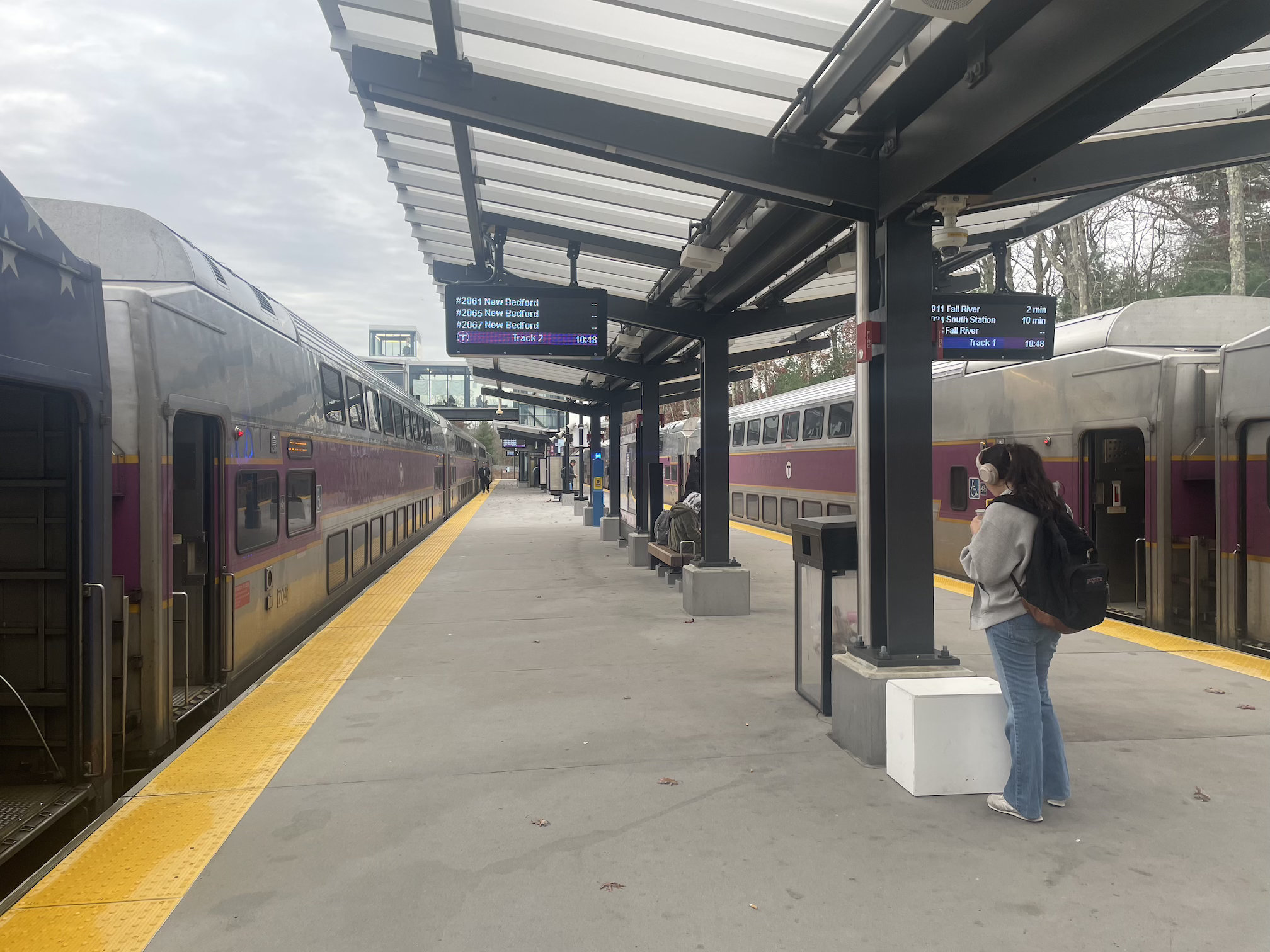Last week, MassDOT and the City of Peabody presented their proposed plans to extend the town's Independence Greenway from Lahey Medical Center across Route 128 to Endicott Street, a project that will bring the shared-use path to the edge of Peabody’s downtown area.
Currently, the Independence Greenway is made up of two disconnected sections which run on either side of Route 1 and I-95.
The western section runs from Lieutenant Ross Park for about 3 miles before ending at Russell Street, near Peabody’s northwest border; the eastern section runs from Peabody Road to the Lahey Medical Center, between Route 1 and Route 128.
At a virtual public hearing for the project on June 22, Stephanie Upson, MassDOT Project Manager, presented the 25% design plans to extend the eastern trail segment further eastward, under Route 128, down Northshore Road to Proctor Brook, and along the brook to Endicott Street in Peabody’s downtown district.
“The proposed design is intended to provide the highest level of service to bicyclists and pedestrians, providing protection from vehicles and limiting the number of crossings to every extent possible,“ said Upson.
The team is ambitious about providing a continuous path for bicyclists, pedestrians and other path users, and will even eliminate a lane from a multi-lane underpass under Route 128 in order to accommodate the shared use path.
“This design underwent a traffic analysis and the traffic impacts associated with reducing two lanes down to one were limited, where the maximum increase in delay for vehicles would be about 6 seconds per vehicle,“ said Upson.

East of Northshore Road, the Proctor Brook section of the path will extend about 4,000 feet east to Endicott Street, the end of the project.
The crossing from Northshore Road to Proctor Brook will include a rectangular flashing beacon which will have “a passive detection such that a rider or someone walking will only need to wait at the crossing for the beacons to activate,“ explained Upson.

The path along Proctor Brook will include several crossings in order to protect the wetlands. “Three of the (four) crossings are going to be over culverts where the bank will be stabilized and an approximate 400-foot long boardwalk will be installed as another crossing,'' said Upson.
MassDOT expects to have final design plans in January 2023 for construction, which will last approximately one year, to begin in spring 2024.
A separate MassDOT project to connect the eastern and western segments of the Independence Greenway, and also connect the Greenway to the Danvers Rail Trail, is also in the planning stages and could be built on a similar timeline (that segment would follow the red-dashed line in the map at the top of this article).
“We anticipate the 25% design phase (for that project) to be completed in August of this year, and we will most likely have a design public hearing similar to this one probably in the winter, this upcoming winter,” shared Brendan Callahan, Assistant Director of Planning for the City of Peabody.
The Independence Greenway is not only a key piece in connecting nearby towns like Salem and Middleton, but also plays a role in the regional trail network.
According to Callahan, “Developing this segment on the Independence Greenway will meet the state's goal to fill trail gaps along the Border to Boston Trail, a 70-mile shared use path that links approximately 20 communities from Boston to Newburyport.”
Callahan added, “this crossing also is part of the nationally known East Coast Greenway, which is a 3000- mile greenway from Maine to Florida connecting 15 states and 450 cities.”
Callahan also discussed several other new Border to Boston trail projects that are in the works.
“From Wallis Street to Howley Street, which is essentially the border of Salem, we are currently advancing what is known as the Riverwalk,” he said.
Peabody's Riverwalk trail segment is nearly ready for construction, and a connecting segment in Salem is also being designed.
“We've partnered with the City of Salem and they're currently in the 25% design phase from the Howley Street Bridge to Grove Street in Salem. That segment was another trail gap, not only for the Border to Boston Trail, but also a trail gap between the two communities’ Riverwalk projects,” he continued. “Once that section in Peabody’s Riverwalk is constructed, that would create one contiguous greenway from essentially the downtown Peabody Post Office to the Salem MBTA Commuter Station, which is approximately 1.6 miles, ultimately connecting both downtowns via this Greenway.”
MassDOT is accepting comments on the proposed trail design; submit your feedback to MassDOTProjectManagement@dot.state.ma.us






